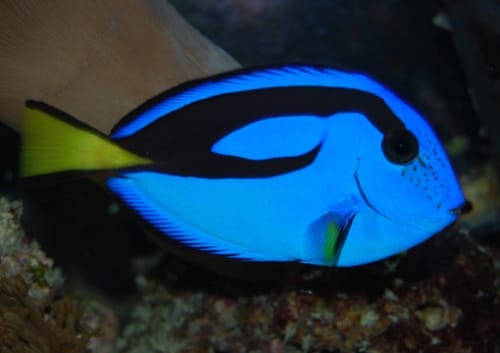Blue Tang Information
The Blue Hippo or Pacific Regal Tang is generally a hardy and easy fish to keep once it becomes comfortable and established in an appropriate sized aquarium. Yet, acclimating and introducing a new Blue Tang can be frustrating to hobbyists of any skill level because they are very prone to Ich.
It is a good practice to quarantine any new fish you purchase, but quarantining a Blue Hippo Tang is a must! In a quarantine tank, you can observe the feeding habits and medicate the fish as necessary. After the quarantine period, introduce the fish into the display aquarium and continue to monitor for any signs of disease. Once introduced, the Blue Tang can be a difficult fish to remove because it can wedge itself into caves and hard to reach places in live rock. This makes it particularly challenging to remove a sick fish.

Blue Hippo Tang & Ich
If your Blue Tang becomes infected with Ich in a reef aquarium, remove it from the aquarium and place it into quarantine. Treat with a Copper Based Ich Medication until the fish is disease free, some experts recommend up to a six week quarantine period before placing the fish back into the display aquarium. Do not use copper based medication in a reef tank because it is toxic to corals and invertebrates. If your Blue Tang becomes infected with Ich in a fish only Aquarium you have the option of treating the entire aquarium with a copper based Ich medication or quarantining the fish. You may treat your whole aquarium if you have no intention of keeping a reef environment with invertebrates and corals. Treating with copper will inhibit the aquarium, live rock, filters and substrate from ever being used in a reef aquarium. Other experts have advocated the use of a UV Sterilizer to treat and prevent Ich. Although these sterilizers are highly effective and will guard against ich, they aren’t necessary and will not replace the selection of a healthy Pacific Regal Tang.
Buying a Blue Hippo Tang
When selecting a Blue Hippo Tang, avoid specimens smaller than two inches. These fish have terrible survival rates, but are often purchased by hobbyists because they are cute, or they think it will be a good addition to a nano fish tank. Instead, look for a Blue Tang that is at least three inches, appears to be disease free, is active in the aquarium and is eating well. There is controversy about the minimum aquarium size required for a small Blue Tang. In general, a Blue Tang requires an aquarium at least four feet long with plenty of rockwork where the fish can hide and a long stretch where the fish can swim. Most Blue Tangs will quickly outgrow a 55 gallon aquarium, so be prepared to trade it in as the fish grows in size. Please note, these fish can grow to 12 inches and have spikes on each side of the tail. They will flare these spikes when scared or threatened, so caution should be taken when handling.
